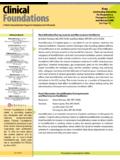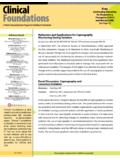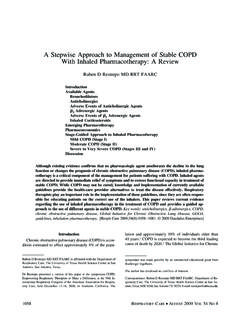Transcription of Early intensive care unit mobility therapy in the ...
1 Early intensive care unit mobility therapy in the treatment ofacute respiratory failurePeter E. Morris, MD; Amanda Goad, RN; Clifton Thompson, RN; Karen Taylor, MPT; Bethany Harry, MPT;Leah Passmore, MS; Amelia Ross, RN, MSN; Laura Anderson; Shirley Baker; Mary Sanchez;Lauretta Penley; April Howard, RN; Luz Dixon, RN; Susan Leach, RN; Ronald Small, MBA;R. Duncan Hite, MD; Edward Haponik, MDImmobility, deconditioning andweakness are common problemsin mechanically ventilated pa-tients with acute respiratory fail-ure, and may contribute to prolongedhospitalization (1, 2). Although physicaltherapy has a theoretical appeal and mayaddress this problem, it has not been de-termined whether physical therapy hasincreased benefit when initiated earlyduring intensive care unit (ICU) treat-ment. There may be perceived barriers tothe consistent delivery of passive range ofmotion (PROM) and physical therapy inmany ICUs, namely concern over appara-tus dislodgement, integration of mobilitywith sedation needs, costs of physicaltherapists in ICUs and time restraints ofboth nurses and physical therapists (3).
2 Although exercise has been shown to im-prove functional outcome in emphysemaand heart failure in the outpatient set-ting, few data exist regarding whetherearly mobility of the medical ICU patientwill improve outcomes (4, 5).Physical therapy practice in the ICUsetting varies greatly from one setting toanother (6). One reason for the observedvariability in the delivery of physical ther-apy to ICU patients may be the lack of auniform protocolized approach for ICUdelivery of physical therapy . Such proto-cols exists for other ICU interventions:weaning from mechanical ventilation,liberation from sedation, and Early goaldirected therapies for severe sepsis (7 9).To our knowledge there are no previousstudies that assess efficacy, cost-benefit,or hospital or long-term benefits of earlyICU mobility therapy in medical ICU pa-tients. As part of a quality improvementproject we developed a standard physicaltherapy protocol for use in medical ICUpatients.
3 In our ICUs physical therapy ispart of usual care ; however, delivery andadministration of physical therapy is of-ten infrequent and occurs mobility protocol was designed toprovide a mechanism ( , the protocolFrom the Section on Pulmonary, Critical care ,Allergy and Immunologic Diseases (PEM, AH, RDH, EH),and Public Health Sciences (LP), Wake Forest Univer-sity School of Medicine, Winston Salem, NC; Depart-ments of Nursing and Physical therapy (AG, CT, KT,BH, AR, LA, SB, MS, LP, LD, SL, RS), North CarolinaBaptist Hospital, Winston Salem, , in part, by The North Carolina BaptistHospital and The Claude D. Pepper Older AmericansIndependence Center of Wake Forest University, NIHG rant authors have not disclosed any potential con-flicts of information regarding this article, 2008 by the Society of Critical CareMedicine and Lippincott Williams & WilkinsDOI: :Immobilization and subsequent weakness are con-sequences of critical illness.)
4 Despite the theoretical advantages ofphysical therapy to address this problem, it has not been shownthat physical therapy initiated in the intensive care unit and Setting:Prospective cohort study in a universitymedical intensive care unit that assessed whether a mobilityprotocol increased the proportion of intensive care unit patientsreceiving physical therapy vs. usual :Medical intensive care unit patients with acute re-spiratory failure requiring mechanical ventilation on admission:Protocol, n 165; Usual care , n :An intensive care unit mobility Team (criticalcare nurse, nursing assistant, physical therapist) initiated theprotocol within 48 hrs of mechanical and Main Results:The primary outcome wasthe proportion of patients receiving physical therapy in patientssurviving to hospital discharge. Baseline characteristics weresimilar between groups.
5 Outcome data are reflective of Protocol patients received at least one physical therapysession than did Usual care (80% vs. 47%,p<.001). Protocolpatients were out of bed earlier (5 vs. 11 days,p<.001), hadtherapy initiated more frequently in the intensive care unit (91%vs. 13%,p<.001), and had similar low complication ratescompared with Usual care . For Protocol patients, intensive careunit length of stay was vs. days for Usual care (p .025);hospital length of stay for Protocol patients was vs. daysfor Usual care (p .006) ( intensive care unit /hospital length ofstay adjusted for body mass index, Acute Physiology and ChronicHealth Evaluation II, vasopressor). There were no untoward eventsduring an intensive care unit mobility session and no cost differ-ence (survivors nonsurvivors) between the two arms, includingMobility Team :A mobility Team using a mobility protocol initi-ated earlier physical therapy that was feasible, safe, did notincrease costs and was associated with decreased intensive careunit and hospital length of stay in survivors who received physicaltherapy during intensive care unit treatment compared with pa-tients who received usual care .
6 (Crit care Med 2008; 36:000 000)KEYWORDS: respiratory failure; mechanical ventilation; mobility ; intensive care units; physical therapy ; passive range of motion1 Crit care Med 2008 Vol. 36, No. 8and mobility Team) for standard and fre-quent (once every day) administration ofphysical therapy to acute respiratory fail-ure purpose of this study was to assessthe frequency of physical therapy , site ofinitiation of physical therapy , and patientoutcomes comparing respiratory failurepatients who received usual care com-pared with patients who received physicaltherapy from a mobility Team using themobility AND METHODSS tudy were identifiedprospectively and enrolled in the study within48 hrs of intubation and 72 hrs of admission tothe Medical intensive care unit (MICU). Studyinclusion criteria were age 18 yrs and me-chanically ventilated via an endotracheal criteria were inability to walk with-out assistance before acute ICU illness (use ofa cane or walkers were not exclusions), cogni-tive impairment before acute ICU illness (non-verbal), preadmission immunocompromisedstatus (prednisone 20 mg/d for 2 wks), neu-romuscular disease that could impair weaning(myasthenia gravis, amyotrophic lateral scle-rosis, Guillian-Barre), acute stroke, body massindex (BMI)
7 45, hip fracture, unstable cervi-cal spine or pathologic fracture, mechanicalventilation 48 hrs before transfer from anoutside facility, current hospitalization ortransferring hospital stay 72 hrs, cardiopul-monary resuscitation at admission, DNR atadmission, hospitalization within 30 days be-fore admission, cancer therapy within last 6months, readmission to ICU within currenthospitalization. The reason represented in thelisting of immunocompromised as an exclu-sion was because of the potential difficulty inassessing muscle strength in patients on long-term was determineda priorithat only pa-tients who survived to a hospital dischargewould be included in the outcome analysesbased on results of prestudy data that foundfew patients who died in the ICU achievedsufficient wakefulness to be considered forphysical therapy before their death.
8 Thus, out-come data were compared for patients in theUsual care group with patients in the Protocolgroup who survived to hospital discharge. Asample size of 135 survivors per group pro-vided 80% power to detect a difference in thepercent of patients receiving physical therapyof at least 20% between groups, using a twosided test and a 5% significance part of a qualityimprovement initiative to improve patientoutcomes a mobility protocol was designed toinitiate and deliver daily mobility therapy tomedical ICU patients. The protocol was devel-oped with involvement of nursing, physicaltherapy, and intensivists. All care deliveredunder this protocol was already governed bythe hospital s Nursing and Physical TherapyDepartments policies and procedures, , nonew experimental movement procedures wereintroduced. This study had Wake Forest Uni-versity Health Sciences Institutional ReviewBoard approval and informed consent were assigned to receive themobility protocol by unit using a block allo-cation design.
9 The MICU physician service ad-mitted patients to seven separate ICU unitsbased on bed availability. The mobility Teamrotated among the ICUs (set order) until 50patients per arm had been enrolled in a block,(but completed treatment on enrolled pa-tients) and then the mobility Team rotated tothe next block of patients. Units were assignedto the intervention and control groups in eachblock to maintain the balance of enrollmentover time. A total of three blocks were usedover the course of the study, with each unitassigned to both intervention and controlgroups at different points in time. Patients inthe other ICUs, without the mobility Team,were also enrolled in the study but receivedusual physical therapy care ( , Usual Caregroup). Thus, eligible patients were designatedto either the Protocol or Usual care group,based on whether or not they were in one ofthe ICUs where the mobility Team was as-signed.
10 Protocol patients received mobilitytherapy until transferred to a regular hospitalbed. All patients were managed using proto-cols for sepsis resuscitation, intravenous insu-lin for glycemic control, sedation with dailyinterruption, and liberation from mechanicalventilation (7 10). The mobility Team s repre-sentation was that across the seven ICUs towhich a medicine service patient could be ad-mitted, there was a 1:1 coverage of MobilityTeam coverage of Protocol beds to UsualCare patients were medical ICU service pa-tients; there were no surgical or trauma ad-missions to the project. The medical ICU ser-vice is not geographically limited to just oneunit in our hospital but has patients every dayin each of the seven units. Patients are as-signed beds on a first come, first served ICU beds stay 95 % occupied. Each of theseven units accepted medical and surgical pa-tients.


